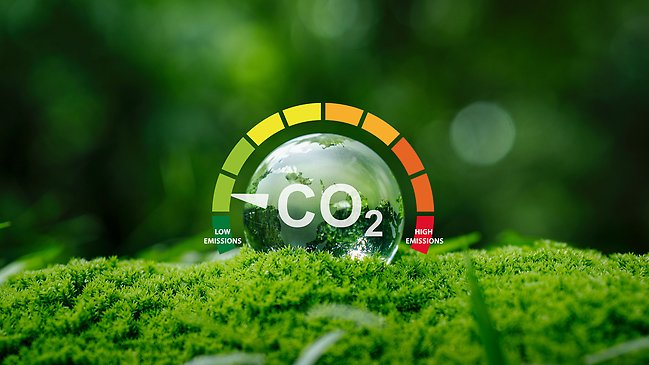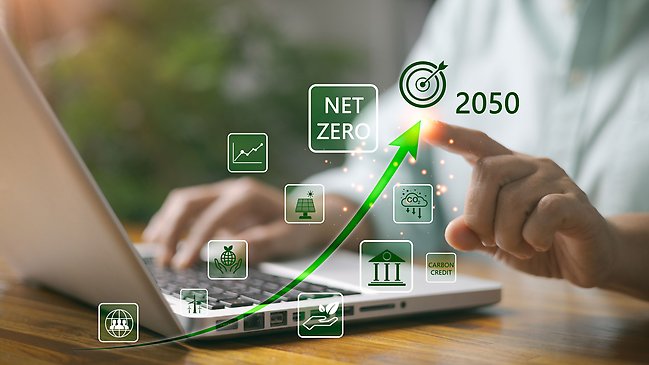Metrics and targets
NIBE has established three energy and climate-related targets related to climate change mitigation and adaptation.
The targets include all of NIBE’s operations except activities acquired during the reporting period, since their sustainability reporting will not begin until they have been part of the Group for a full reporting period. Our targets are followed up and evaluated annually. Both our energy targets and climate-related targets use the base year 2019, which we consider to be a representative base year.
Reduce energy use by 40%
According to our energy target, we should reduce our energy use by 40% by 2030 compared with 2019 as the baseline (measured in MWh/SEK million in sales). The energy included in the target calculation is purchased energy in the form of electricity and fuels for our operations and vehicles, but not our self-generated energy. However, self-generated energy is included in the presentation of energy consumption and mix and in the calculation of energy intensity on page 77. The target is linked to our environment and climate focus areas as well as use of our energy-efficient products.
Reduce GHG emissions by 65%
Our GHG emissions target is aimed at reducing direct (Scope 1) and indirect (market-based Scope 2) GHG emissions by 65% by 2030 compared with the base year 2019. We consider this to be an ambitious target because the cross-sector emission pathway recommended by SBTi requires a reduction of at least 57% in the same period.
70% LCE-classified products
Our target for increased climate benefit in our product portfolio is for 70% of our sales to consist of LCE-classified products by the end of 2026. The target covers all subsidiaries and is calculated as the ratio of LCE-classified products in relation to the entire Group’s sales over a financial year.
FTSE LCE ICS™ (Financial Times Stock Exchange Low Carbon Economy Industrial Classification System) is a quantitative model designed to permit investors to assess a company’s ability to adapt its business to the requirements related to reduced climate impact. Product groups included in LCE: heat pumps, district heating, boilers, stoves for burning pellets and wood, PV panels, heat exchangers, components for rail, electric and hybrid vehicles, ventilation and building cooling, and renewable energy production.
Retrospective | Milestones and target years | ||||||
Base year | 2023 | 2024 | Change % | 2030 | 2050 | Annual % target / Base year | |
Scope 1 GHG emissions | |||||||
Gross Scope 1 GHG emissions (tCO2eq) | 36,413 | 34,694 | 29,977 | -14% | 12,744 | – | -65% |
“Percentage of Scope 1 GHG emissions from regulated emission trading schemes (%)" | 0% | 0% | 0% | 0% | – | – | – |
Scope 2 GHG emissions | |||||||
Gross location-based Scope 2 GHG emissions (tCO2eq) | 60,801 | 58,841 | 56,576 | -4% | 21,280 | – | -65% |
Gross market-based Scope 2 GHG emissions (tCO2eq) | 11,449 | 2,680 | 1,090 | -59% | 4,007 | – | -65% |
Significant Scope 3 GHG emissions | |||||||
Total Gross indirect Scope 3 GHG emissions (tCO2eq) | – | 42,020,907 | 46,795,935 | 11% | – | – | – |
1 Purchased goods and services | – | 359,001 | 563,253 | 57% | – | – | – |
11 Use of sold products | – | 41,349,641 | 45,985,391 | 11% | – | – | – |
Other categories | – | 312,265 | 247,291 | -21% | – | – | – |
Total GHG emissions | |||||||
Total GHG emissions | 97,213 | 42,114,442 | 46,882,488 | 11% | – | – | – |
Total GHG emissions | 47,862 | 42,058,281 | 46,827,001 | 11% | – | – | – |
Scope 1 and 2
The calculation of our GHG emissions was carried out on accordance with the principles, requirements and guidance in the GHG Protocol. The emission factors for Scope 1 and 2 are from Swedish Energy Agency Heat values 2024, Swedish Environmental Protection Agency Emission factors 2024, DEFRA (UK Government GHG Conversion Factors for Company Reporting), IEA - International Energy Agency and the cooling and heat pump trade association Svenska Kyl & värmepumpföreningen. Conversion factors were obtained from the Swedish Energy Agency and Energigas.se.
Our Scope 1 biogenic emissions come from combustion of bioethanol, biodiesel, pellets and biogas. Biogenic emissions also occur in Scope 2 in connection with production of electricity and district heating, but we do not have information on emissions from district heating. The same applies to our indirect biogenic CO2 emissions under Scope 3. In the coming years, we will take measures to enable disclosure of our biogenic CO2 emissions under both Scope 2 and Scope 3. Scope 3 biogenic emissions mostly occur during the use phase of our sold pellet- or wood-fired stove products.
100% of purchased electricity is bundled with instruments in the form of Guarantees of Origin (GoO), International Renewable Energy Certificates (IREC), Renewable Energy Certificates (REC) and Renewable Energy Guarantees of Origin (REGO). This electricity accounts for 94% of all purchased electricity under Scope 2. Guarantee of Origins are purchased centrally for the Group as a whole.
Scope 3
We have carried out calculations for our indirect Scope 3 emissions for all categories Scope 3 GHG emissions are mostly calculated using assumptions and estimates. Of the total of 15 categories, we measured activity data from our Group companies for the following categories:
1 Purchased goods and services
3 Fuel and energy-related activities
4 Upstream transportation and distribution
5 Waste generated in operations
6 Business traveling
For the remaining categories, estimates of activity data are made at Group level. No calculation tools intended specifically for GHG emission calculations were used to calculate emissions. Of our total Scope 3 GHG emissions, less than 1% relates to primary data received from suppliers or other value chain partners.



